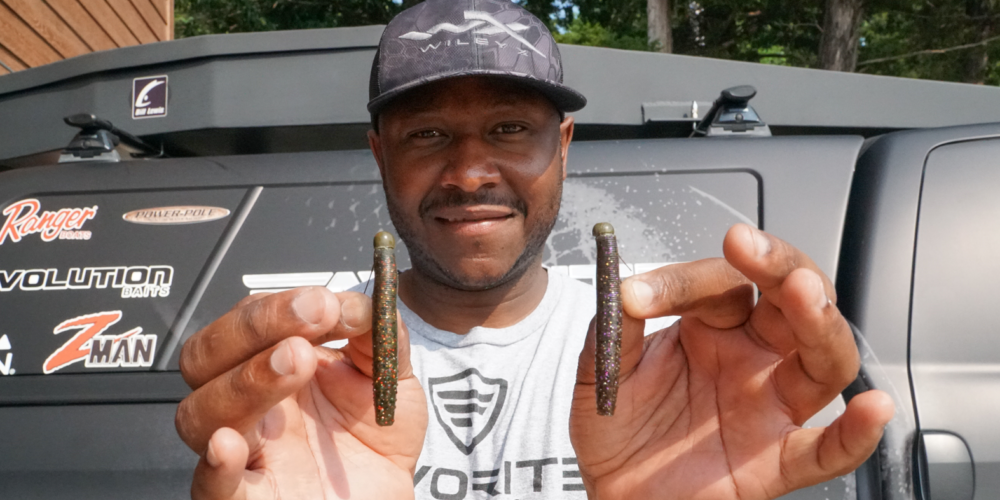A Spotted Bass Tutorial with Dustin Connell and Mark Daniels, Jr.

BRANSON, Mo. – Of the big most well-known species of black bass, the spotted bass is seen as the wiliest, the most unpredictable and as a result, likely the least understood. This week at Table Rock Lake for Stage Seven, they are a significant factor, and catching plenty of them will be crucial to keep up with the rest of the field.
Spotted Subspecies
Currently, there are two official species of spotted bass: the Northern, and the rare Wichita spotted bass. A third, the Alabama bass, was formerly referred to as a spotted bass species, but in 2008 it became a distinct species.
Dustin Connell is an ace when it comes to the chasing big Coosa River bass, but those are technically Alabama bass, even though they are widely thought to be spotted bass.
“The Alabama bass around my house are strictly current oriented, and if the water is moving, they’re going to bite,” Connell says. “They also get in much shallower water than true spotted bass and act more like largemouth.”
All three of these bass look similar but act a little differently. Here on Table Rock, it’s the Northern spotted bass, also called Kentucky spotted bass or simply “Kentuckies”.
“A spotted bass doesn’t get nearly as big as Alabama bass and usually only goes to shallow water around the spawn, and the rest of the time, you will usually find them in deep water,” Connell adds.
Fishing for Spotted Bass
One thing that makes spotted bass such a favorite among anglers is how voracious they are.
“Spots are the meanest bass out there, in my opinion. Even smallmouth are not as aggressive,” Connell says. “Spotted bass also love to group up. If you catch a spotted bass, it is only because he is mad that his buddy was going to bite your bait first.”
Alabama pro Mark Daniels, Jr. agrees, and says that spots tend to be much more aggressive than their largemouth cousins.
“They also don’t need structure to feel comfortable,” Daniels says. “I’ve seen spots busting on shad on the surface in 100-feet of water, but they mostly congregate on offshore ledges, drop-offs and they also like to suspend around standing timber.”
“They act similar to stripers and hybrids in how they chase baitfish, and many times they will be mixed in right with them.”
Table Rock Spots
As we saw in Stage Six and here in the early part of Stage Seven, spotted bass are a major player on Table Rock Lake. Connell and Daniels, Jr. explain how they act here.
“They get schooled up big time this time of year and can be really easy to catch when you find them,” Connell advises. “Spotted bass like to get offshore, and you can find them on channel bends and flats with a little bit of current. Another place to look is on long main-lake points, and they tend to sit on the windblown side and will move up with the current or water movement from the wind.”
Daniels, Jr. has a similar assessment.
“You can go down any bluff bank here and start picking them off, but as the water warms they will get deeper and deeper,” he says. “Right now most are in around 25 feet of water, but they can be in 50 feet and deeper water in August.”

Spotted Bass Baits
When asked what baits he likes for spotted bass, Daniels, Jr. says he reaches for finesse.
“You can catch them on power fishing techniques, but it is usually more finesse for me,” he confirms. “I like to fish a Ned Rig with the Z-Man T.R.D. and also a drop-shot rig. The drop-shot is mandatory for spotted bass.”
Connell has a different outlook and said that finesse fishing for spotted bass is often seen as the only way to go, but he generally likes to fish moving baits.
“If I had to pick up one bait to catch spotted bass on it would be a jerkbait,” says the Favorite Fishing pro. “I also like swimbaits, topwater walking baits, and then a shaky head. Those four baits will catch spotted bass everywhere all year round.”
Table Rock is home to largemouth, smallmouth and spotted bass, but the spotted bass appears to be the story at Stage Seven. Anglers will be tested this week as they search for the biggest schools of spotted bass they can find, and whoever succeeds will likely go home with the trophy.